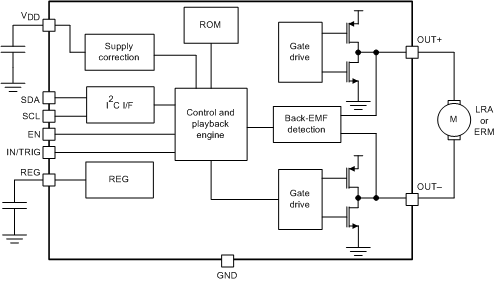SLOS825E December 2012 – April 2018 DRV2605
PRODUCTION DATA.
- 1 Features
- 2 Applications
- 3 Description
- 4 Revision History
- 5 Pin Configuration and Functions
- 6 Specifications
-
7 Detailed Description
- 7.1 Overview
- 7.2 Functional Block Diagram
- 7.3
Feature Description
- 7.3.1 Support for ERM and LRA Actuators
- 7.3.2 Smart-Loop Architecture
- 7.3.3 Open-Loop Operation for LRA
- 7.3.4 Open-Loop Operation for ERM
- 7.3.5 Flexible Front-End Interface
- 7.3.6 Edge Rate Control
- 7.3.7 Constant Vibration Strength
- 7.3.8 Battery Voltage Reporting
- 7.3.9 One-Time Programmable (OTP) Memory for Configuration
- 7.3.10 Low-Power Standby
- 7.3.11 Device Protection
- 7.4 Device Functional Modes
- 7.5
Programming
- 7.5.1 Auto-Resonance Engine Programming for the LRA
- 7.5.2 Automatic-Level Calibration Programming
- 7.5.3 I2C Interface
- 7.5.4 Programming for Open-Loop Operation
- 7.5.5 Programming for Closed-Loop Operation
- 7.5.6 Auto Calibration Procedure
- 7.5.7 Programming On-Chip OTP Memory
- 7.5.8 Waveform Playback Programming
- 7.6
Register Map
- 7.6.1 Status (Address: 0x00)
- 7.6.2 Mode (Address: 0x01)
- 7.6.3 Real-Time Playback Input (Address: 0x02)
- 7.6.4 (Address: 0x03)
- 7.6.5 Waveform Sequencer (Address: 0x04 to 0x0B)
- 7.6.6 GO (Address: 0x0C)
- 7.6.7 Overdrive Time Offset (Address: 0x0D)
- 7.6.8 Sustain Time Offset, Positive (Address: 0x0E)
- 7.6.9 Sustain Time Offset, Negative (Address: 0x0F)
- 7.6.10 Brake Time Offset (Address: 0x10)
- 7.6.11 Audio-to-Vibe Control (Address: 0x11)
- 7.6.12 Audio-to-Vibe Minimum Input Level (Address: 0x12)
- 7.6.13 Audio-to-Vibe Maximum Input Level (Address: 0x13)
- 7.6.14 Audio-to-Vibe Minimum Output Drive (Address: 0x14)
- 7.6.15 Audio-to-Vibe Maximum Output Drive (Address: 0x15)
- 7.6.16 Rated Voltage (Address: 0x16)
- 7.6.17 Overdrive Clamp Voltage (Address: 0x17)
- 7.6.18 Auto-Calibration Compensation Result (Address: 0x18)
- 7.6.19 Auto-Calibration Back-EMF Result (Address: 0x19)
- 7.6.20 Feedback Control (Address: 0x1A)
- 7.6.21 Control1 (Address: 0x1B)
- 7.6.22 Control2 (Address: 0x1C)
- 7.6.23 Control3 (Address: 0x1D)
- 7.6.24 Control4 (Address: 0x1E)
- 7.6.25 V(BAT) Voltage Monitor (Address: 0x21)
- 7.6.26 LRA Resonance Period (Address: 0x22)
- 8 Application and Implementation
- 9 Power Supply Recommendations
- 10Layout
- 11Device and Documentation Support
- 12Mechanical, Packaging, and Orderable Information
Package Options
Mechanical Data (Package|Pins)
- YZF|9
Thermal pad, mechanical data (Package|Pins)
Orderable Information
3 Description
The DRV2605 device is designed to provide extremely-flexible haptic control of ERM and LRA actuators over a shared I2C-compatible bus. This control relieves the host processor from ever generating pulse-width modulated (PWM) drive signals, saving both costly timer interrupts and hardware pins.
The DRV2605 device provides an extensive integrated library over 100 licensed effects from Immersion for ERM and LRA which eliminates the need to design haptics waveforms.
The DRV2605 device offers a licensed version of the TouchSense 2200 software from Immersion, which includes the 2200 Effects Library, and 2200 audio-to-vibe features. Additionally, the real-time playback mode allows the host processor to bypass the library playback engine and play waveforms directly from the host through I2C.
The DRV2605 device also contains a smart-loop architecture, which allows effortless auto resonant drive for LRA as well as feedback-optimized ERM drive. This feedback provides automatic overdrive and braking, which creates a simplified input waveform paradigm as well as reliable motor control and consistent motor performance. The audio-to-haptics mode automatically converts an audio input signal to meaningful haptic effects.
The DRV2605 device features a trinary-modulated output stage, providing greater efficiency than linear-based output drivers. The 9-ball WCSP footprint, flexible operation, and low component count make the DRV2605 device the ideal choice for portable and touch-enabled vibratory and haptic applications.
For an important notice regarding Immersion software, see the Legal Notice section.
Device Information(1)
| PART NUMBER | PACKAGE | BODY SIZE (MAX) |
|---|---|---|
| DRV2605 | DSBGA (9) | 1.50 mm × 1.50 mm |
- For all available packages, see the orderable addendum at the end of the datasheet.
